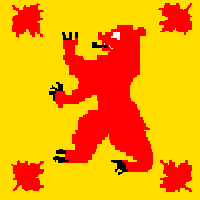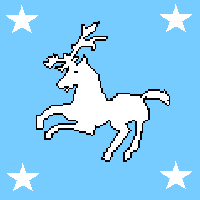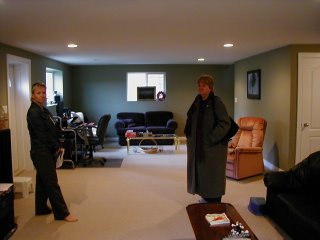Being a record of an imaginary 18th century Germanic principality as relating to
the design and construction of a tabletop army for gentlemanly wargaming.
Tuesday, March 27, 2007
Well, in a little over a month we will be moving into our new home and I will finally be able to get all of my paints out of storage. I'm really looking forward to finally getting to paint figures again.
And, of course, my first order of business will be to begin work on my Saxe-Bearstein troops. To that end, today I placed an order with the Dayton Painting Consortium to get the rest of the RSM95 miniatures I need to complete my initial Saxe-Bearstein army.
I say "initial" because I suspect that when I've painted these troops, I'll want to add more units. That seems to always be the way it goes, doesn't it?
I've also asked for a few samples of French SYW troops . . . since I'm still planning (once my Saxe-Bearstein forces are painted) to build an opposing army (working name -- Stagonia). That, of course, lies in the future.
One nagging problem, since we will be moving and I never know how long Canada Post & Canada Customs will delay my order, I've had to ask that they not send it until we're about to move in . . . after all, it wouldn't do to have the figures go to the people moving out . . . which means that there will be a time gap before these figures arrive.
Good thing that I'd ordered others earlier, isn't it?
-- Jeff
Saturday, March 24, 2007
You might already know about it, but I did not. "The Miniatures Atlas" has links to a great many different miniatures companies -- you can also search by several different criteria (sculptor, company, scale, nationality, etc.). Their website (now among my links) is:
http://www.miniaturesatlas.com/
-- Jeff
Friday, March 23, 2007
I just thought that I'd list a few odd details for "Tricorne Wars" Command and Control.
The "command stand" (i.e., the one with the officer on it -- not the "colour stand" which has the flag) should always be in the center of the line when the unit is in "line" formation. This means as the center stand if there are an odd number; or one of the two center stands if there are an even number.
The "Command Distance" is measured from the General's or Brigadier's head to the command stand. If it is at or within the General's/Brigadier's "command radius", then the unit is "in command" and will abide by any order changes (as interpreted by the General/Brigadier).
If outside that distance, they will need to continue to obey their previous orders until the General/Brigadier either moves within range or sends a messenger (i.e., an Aide-de-Camp).
Units act in accordance with their original (starting) orders until they either reach their destination (as indicated by the arrow) OR they make contact with the Enemy. Contact is coming to or within 12" of a mounted unit; or 6" of a formed foot unit. (note that, in both cases, the unit needs to be aware of the enemy unit -- if it has been and remains hidden from them, they ignore it).
Now, when they either reach the end of their arrow OR they come within range of the Enemy, the Brigadier or General will assess his orders in light of what he now sees and decide upon the proper course of action . . . . In other words, at the appropriate time he will roll a die and see how he interprets his orders.
While about two-thirds of the time the order will be "correctly interpreted", about a third of the time it will be interpreted differently. This is intentional . . . it adds to the "fog of war" as well as providing a certain amount of aggrivation on the part of the C-in-C.
-- Jeff
Tuesday, March 20, 2007
Some time back I explained how Generals and Brigadiers in "Tricorne Wars" might (depending upon a die roll) interpret the orders given them.
Today I'm going to post my initial thoughts on what those "orders" might be:
Commands (and, in some cases, individual units -- those "out of command") must operate within the limits of whatever "Orders" they are under (or were last under if "out of command"). While their immediate commanding officer (usually a Brigadier) may have improperly interpreted them -- that doesn't matter -- they must follow his orders as he interpreted them.
The Player C-in-C should diagram the table with arrows drawn from each Command toward their objectives with the Abbreviation of their Orders. If an area is to be Defended, that should be indicated by a rough circle (which may well have an arrow with its own command drawn to it). If the order is "Hold", simply place an "H" by the command. With other orders, indicate the enemy command which is the target of their actions.
Note that references to "all units" do not include any Artillery. Artillery should support their Brigade; but need not (and often will not) advance with it. Generally speaking the only artillery that might move (other than to get into position) during a battle is Light Artillery.
Possible Orders (from most aggressive to least) and their "abbreviations" are:
So that's my current thinking. Comments are appreciated.
-- Jeff
Thursday, March 15, 2007
This is totally "off topic" and has nothing to do with 18th century gaming . . . but it is certainly something cool! Besides, since this is "the ides of March" it is appropriate to mention this.
 Eric Hotz (of "Larry Leadhead" fame) has designed a series of 1/300 scale Roman and Carthaginian galleys and merchant ships (for the galleys to protect) as well as Saxon ships (fairly similar to the later Viking longships).
Eric Hotz (of "Larry Leadhead" fame) has designed a series of 1/300 scale Roman and Carthaginian galleys and merchant ships (for the galleys to protect) as well as Saxon ships (fairly similar to the later Viking longships).These are all available through his "Roman Seas" website, where you can either purchase a CD with the plans or have them delivered to your own computer.
Because these are paper models, most sets are relatively inexpensive. Besides, once you've purchased the plans, you can print and build as many as you want. To learn more and see the many different ships available, go to:
http://www.romanseas.com/
I should mention that Eric also has a lot of 1/300 scale Roman buildings available as well. In addition, he will shortly be coming out with his own rules ("Roman Seas") for these ships soon -- he's been playtesting it a various conventions.
Finally, there's also a Yahoo Group for further discussion of his Roman Seas project. To learn more, go to:
http://games.groups.yahoo.com/group/roman_seas/
By the way, most models are between 4" and 8" long and readily use 5mm or 6mm crews (Baccus is suggested although H&R are used for most photos).
-- Jeff
Sunday, March 11, 2007
With a hearty nod of thanks to the creator of Hesse-Engleburg ( http://hesse-engelburg.blogspot.com/ ), I have added two new 'Imaginary Country' websites to my links on the right.
The first is a blog on the Landgraviate of Hesse-Fedora:
http://hessefedora.blogspot.com/
The other concerns the Pils-Holstein Campaign of 1755:
http://www.warcabinet.pwp.blueyonder.co.uk/pils.htm
So the number of blogs and websites for imaginary Eighteenth Century countries is really growing.
-- Jeff
Friday, March 09, 2007
Okay, essentially he's been semi-blogging for a long time . . . only it has been at his "Geocities" website where's he's kept his various wargames journals.
I've had a link to these for quite some time. But now his blog address is:
http://steve-the-wargamer.blogspot.com
Of particular interest are his links to his WSS project and his collection of Grant's "Table Top Teasers". Both can be found by looking at the "links" on his blog.
Welcome, Steve.
-- Jeff
Pretty much off-topic, but our purchase of our "new" house is fully on track. Here is a link to some thirty (30) pictures of the house. Please note that the current "messes" belong to the current owners (well, mostly their children):
http://www.flickr.com/photos/7292946@N08/
The nice thing, of course is that I get a great big "game room".
-- Jeff
Sunday, March 04, 2007
 The standing red bear is the national symbol of Saxe-Bearstein (as seen in the "National Flag" to the left).
The standing red bear is the national symbol of Saxe-Bearstein (as seen in the "National Flag" to the left).But other nations -- both real and imaginary -- have other symbols. For example, the white deer is the symbol of my "French-style" opposing nation.
I do not yet know what the "national symbols" of the Duchies of Mieczyslaw and the North will be. I'd guess a gold lion for the latter since it is based on Sweden . . . but who knows?
 Murdock is creating an interesting historical background for Mieczyslaw so it could be most anything . . . I'll just have to wait and see.
Murdock is creating an interesting historical background for Mieczyslaw so it could be most anything . . . I'll just have to wait and see.Historically there have been lions, bears, horses, wolves and eagles (lots of eagles) among actual creatures; and things like dragons, griffins and unicorns among imaginary creatures. And, of course, some countries have inanimate symbols.
So, what is (or would be) the national symbol for your imaginary nation?
What color would it be? (common colors -- red, blue, black, white, yellow, green, purple and "natural".)
What color "background" would it usually be found on?
-- Jeff
Thursday, March 01, 2007
Well, my wife and I finally got some very good news today. Yesterday, while house-hunting we finally found one we liked. We made an offer and today (after some back-and-forth counter-offers) it was accepted!
The rough part is that we can't move in for another two months . . . *sigh*.
We've been looking at houses here for almost a year and a half (although we couldn't actually pay for one until our condo in California sold -- which it finally did a month ago).
Our criteria for what we wanted slowly morphed over the months due to what we decided was really important to us and what was available in this area (Comox Valley on Vancouver Island, BC, Canada).
Anyway, one of the things that has not changed is that we wanted something that would give me a "game room". At first we were thinking of an outside "workshop"-type building . . . but recently we'd come to prefer a "Rancher with basement".
For those of you who don't know what this means, it is a house where everything (all living areas) is on the ground floor (no "upstairs"). My dear wife has some medical reasons for avoiding stairs. This means that the Laundry room has to be on the main floor (and not in the basement where it is usually found).
Thus, with all of our "living spaces" on the main floor, the basement would be MINE!
Well, okay, we will be using one of the bedrooms in the basement for our "Guest Bedroom", but the rest is for me.
 The highlight of this is a 15' x 38' room that I can use (or at least use a big chunk of) for my game room. I've posted a couple of pictures of it (note: all of the furniture, etc. belongs to current owners).
The highlight of this is a 15' x 38' room that I can use (or at least use a big chunk of) for my game room. I've posted a couple of pictures of it (note: all of the furniture, etc. belongs to current owners).The first photo is from the "stairs" end of the room. At the far end, you can see my wife (in grey coat) waving at me. On the left side of the photo is the entrance to the "Guest Bedroom", a bathroom and another bedroom which will probably become storage. Not quite visible on the other side is a door to the outside (it is just this side of the short white step-up thing on the floor).
 Picture number two is from the other end of the room. Now you can see the door to outside behind our real estate agent (short white step-up thing is visible behind her).
Picture number two is from the other end of the room. Now you can see the door to outside behind our real estate agent (short white step-up thing is visible behind her).The white door behind my wife (near leather recliner) is to a storage area under the stairs that go up to the main floor. (Alcove entrance to stairs going up is in far corner behind my wife).
Unfortunately it is still a couple of months before the rulers of the Principality of Saxe-Bearstein will move into their new palace.
I can hardly wait.
-- Jeff